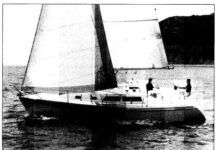Cheoy Lee Offshore 41
An innovative Ray Richards design built by the earliest Asian yard is a rock solid cruiser, but with a lot of teak to maintain as well as potentially troublesome metalwork.
Catalina 30
The entire Catalina line is extremely popular with new boat dealers, who are required by Catalina to represent other lines as well. Usually, the Catalina line is priced about 5% lower than a comparably equipped boat of the same size and type from other manufacturers.
Catalina 320
Catalina Yachts has carved a reputation in the production boat world by producing yachts that make owner feedback sound like a mantra. Typical comments are, "They provide real value for the dollar," "This is not a Swan," "A lot of boat for the money," or, "They sail well enough, considering that most owners are cruisers."
Catalina 34
It doesn't take a lot of brains to see that Catalina is doing something right that a lot of other sailboat makers aren't. They're the largest sailboat builder in the country, and a terrible year for them would be Valhalla for almost every other manufacturer. With more than 1,000 built in seven years, the Catalina 34 has to be in the running as the most successful production boat of the 1980s.
Columbia 36
The Columbia 36 was in production between 1967 and 1972. One reader estimates that more than 600 were built, making it a very successful model. The Columbia 36 was a pretty slick looking boat in its day, and though its lines have worn reasonably well with time, we're reluctant to call it a "classic."
Hunter 23.5
The 23.5 was designed as a trailerable family cruiser for entry-level sailors. Like most Hunters, the boat offers lots of space in the cockpit and down below, and comes with the famous Cruise Pac, which provides just about anything a customer needs, including sails, motor, trailer, lifelines, anchor, life jackets, flares and a copy of Chapman's Piloting, Seamanship and Small Boat Handling.
Hunter 25
By the mid '80s, after only ten years in business, Hunter Marine had become one of the two leaders (with Catalina Yachts) in the volume of auxiliary-sized sailboats on the US market. And, like Catalina, the corporate philosophy at Hunter was to mass produce low priced boats with as few changes in tooling, hence design, as possible.
Pearson 35
The Pearson 35 was introduced in 1968 and remained in production for the next 14 years. In all, 514 P35s were built, almost all for East Coast and Great Lakes owners attracted by the 35's shoal draft (3' 9" with centerboard up) and "classic" proportions. Even the popular Pearson 30, usually heralded as the enduring boat from a builder otherwise noted for its frequent introductions of new boats and short production runs, remained in production only 10 years, albeit with almost 1,200 boats built.
Pearson Triton
The Triton is vintage Alberg--skinny, long overhangs, low freeboard, large mainsail and small foretriangle. Typical of boats designed to the CCA (Cruising Club of America) rule. Alberg was born in Sweden where people love skinny keelboats with long overhangs, such as the Folkboat. It is easy to trace the Triton's lineage to such designs. Credit is also due to Tom Potter, of Jamestown, Rhode Island, who brought the project idea to the Pearsons, and had a hand in its development.
Pearson Vanguard
The Vanguard, designed by Philip Rhodes in 1962, remained in production until 1967, totalling 404 hulls. It was preceded by the Invicta, Alberg 35, Bounty II, Ariel, Rhodes 41, and of course the Triton. This line of fiberglass cruisers and sometime racers gave Pearson a strong position in the market. The pedigree of the designers was odorless, and construction quality was good for that particular moment in the timetable of plastic boatbuilding technology.












































